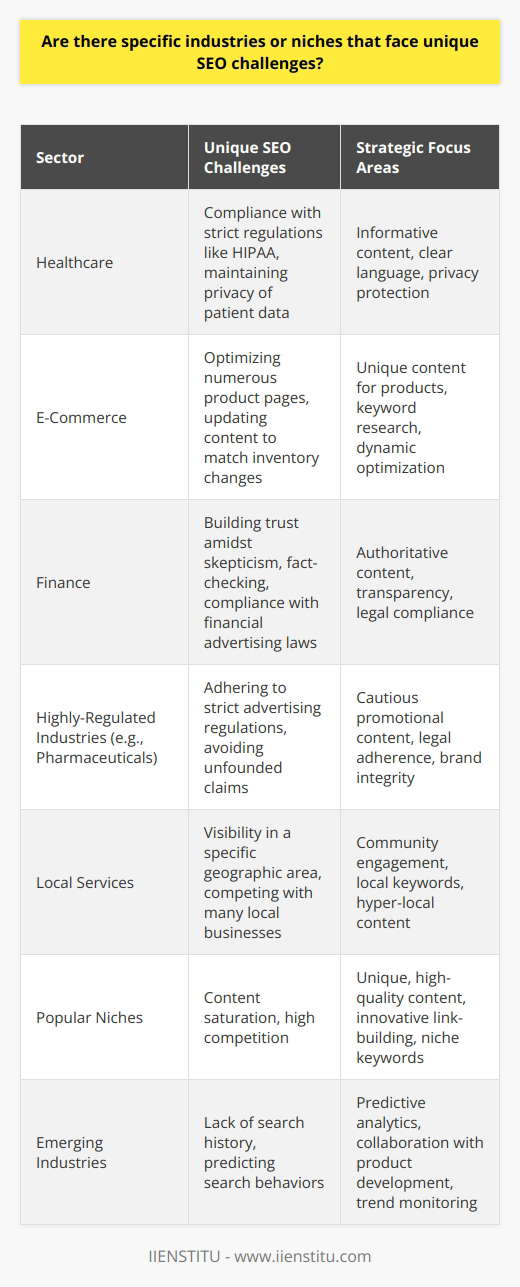
This article discussed what bandwidth is, what bandwidth limits are, and the impact of bandwidth limits. Understanding how bandwidth limits work and their effect on a website is essential to select the right hosting provider.
Introduction
What is Bandwidth?
What are Bandwidth Limits?
The Impact of Bandwidth Limits
Conclusion
Introduction: Bandwidth is essential when selecting a hosting provider for your website. Hosting providers set bandwidth limits to control the number of incoming connections and outgoing data transfers on each server or account. Therefore, it is essential to understand how bandwidth limits work and the impact they can have on your website. This article will discuss what bandwidth is, what bandwidth limits are, and the effects of bandwidth limits.
How To Create A Successful Digital Marketing Strategy For Your Business
Difference Between Seo And Sem İn Digital Marketing Strategy
What is Bandwidth?
Bandwidth is the amount of data that can be transferred over a network connection in a given amount of time. It is measured in bits per second (bps). Bandwidth is essential for websites because it determines how quickly data can be transferred between the web server and the user's device. Therefore, the higher the bandwidth, the faster the data can be shared.
What are Bandwidth Limits?
Hosting providers set bandwidth limits to control the number of incoming connections and outgoing data transfers on each server or account. For example, hosting providers typically fix a limit on the amount of data that can be transferred each month. This limit is usually measured in gigabytes (GB). If the limit is exceeded, the website may slow down or become unavailable until the limit is replenished.
The Impact of Bandwidth Limits
Bandwidth limits can have a significant impact on a website's performance. If the limit is exceeded, the website may slow down or become unavailable until the limit is replenished. This can be especially problematic if a website suddenly goes viral and receives many visitors. In addition, if the website does not have enough capacity, it will either load very slowly or not.
The impact of bandwidth limits can also be felt by businesses that rely on their website for revenue. If the website is unavailable due to bandwidth limits, it can lead to lost revenue and decreased customer satisfaction.
Conclusion: Bandwidth limits are an essential factor to consider when selecting a hosting provider. Understanding how bandwidth limits work and their impact on a website is crucial. If the bandwidth limit is exceeded, the website may slow down or become unavailable until the limit is replenished. This can significantly impact a website's performance and businesses that rely on its website for revenue.
Don't be left behind; stay ahead of the game by understanding SEO & bandwidth limits.

Frequently Asked Questions
What are the key benefits of understanding SEO and bandwidth limits?
Understanding the basics of Search Engine Optimization (SEO) and bandwidth limits cannot be denied. SEO improves a website's ranking in search engine result pages (SERPs) by optimizing its content, structure, and design. Bandwidth limits refer to the amount of data transferred between a website and its users in a given time. Understanding SEO and bandwidth limits are essential for website owners to ensure their websites are optimized for search engine rankings and provide a good user experience.
In terms of SEO, understanding the fundamentals of SEO can help website owners to increase their website's rankings in SERPs. This can be achieved by optimizing the website's content, structure, and design. For example, optimizing the website's meta tags, titles, and descriptions can improve the website's visibility and click-through rate in SERPs. Optimizing the website's structure, such as internal links, can improve search engine rankings. Finally, optimizing the website's design can ensure that the website is user-friendly, providing a better user experience.
Understanding bandwidth limits are also essential for website owners. Bandwidth refers to the amount of data transferred between a website and its users. If a website exceeds its bandwidth limit, it can be slow to load or even stop working altogether. This can lead to a poor user experience and decreased SERP rankings. To prevent this, website owners must be aware of their website's bandwidth limits and ensure that their website is not exceeding them.
In conclusion, understanding SEO and bandwidth limits are essential for website owners to optimize their websites for search engine rankings and to provide a good user experience. By optimizing the website's content, structure, and design and being aware of its bandwidth limits, website owners can ensure that their website is optimized for search engine rankings and provides a good user experience.
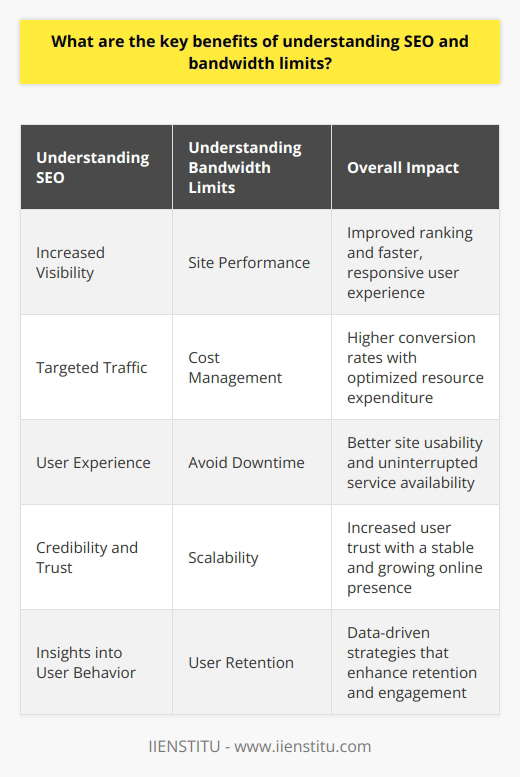
How can I optimize my website for better SEO performance?
Search Engine Optimization (SEO) is essential in getting your website to appear in search engine results. By optimizing your website for better SEO performance, you can ensure that your website not only shows up in search engine results but also ranks higher and is more likely to be clicked on.
There are a few essential steps to optimize your website for better SEO performance. First, make sure to have relevant and up-to-date content on your website. Content that is well-written and contains keywords pertinent to your topic will help your website rank higher in search engine results. Additionally, you should include meta tags and page titles, as these are important for SEO purposes.
Second, you should ensure your website is easy to navigate and user-friendly. This includes optimizing the website’s mobile version, as many searches are now done on mobile devices. Additionally, make sure to link to other pages on your website, as this will help search engine bots crawl and index your pages more quickly.
Third, you should try to get as many backlinks as possible. Backlinks are incoming links from other websites to yours. As long as the backlinks are from reputable websites, this will help your website rank higher in search engine results. You should also try getting as many social media shares as possible.
Finally, you should make sure your website is optimized for speed. Slow-loading websites will not rank well in search engine results, so optimize your website’s loading time. You can do this by using caching plugins and optimizing images.
Optimizing your website for better SEO performance can ensure that your website shows up in search engine results, ranks higher, and is more likely to be clicked on.

What are the potential risks of exceeding bandwidth limits?
Exceeding bandwidth limits can be a common problem for websites and applications. As data usage becomes more and more prevalent, it is essential to understand the potential risks associated with exceeding bandwidth limits.
Bandwidth is the amount of data transmitted over a specific period. Many websites and applications have limits on how much data they can share in a given period. If these limits are exceeded, they can have severe impacts on the performance of a website or application.
One of the most significant risks associated with exceeding bandwidth limits is an increased risk of data loss. If the bandwidth limit is exceeded, the data transmission process may not be able to complete, resulting in the data being lost. Additionally, the website or application may experience performance issues due to the excess data being transmitted. This could cause the website or application to become unresponsive or even crash.
Another potential risk of exceeding bandwidth limits is increased costs. The website or application may be charged for the transmitted excess data if the bandwidth limit is exceeded. This can add up quickly and significantly increase the overall cost of running the website or application.
Finally, exceeding bandwidth limits can lead to security vulnerabilities. If the website or application transmits large amounts of data, it can be more vulnerable to attack. This can lead to the website or application being compromised, exposing sensitive data.
In conclusion, it is essential to understand the potential risks associated with exceeding bandwidth limits. Exceeding these limits can lead to data loss, performance issues, increased costs, and security vulnerabilities. It is essential to be aware of these risks and take steps to ensure that the bandwidth limit is not exceeded.
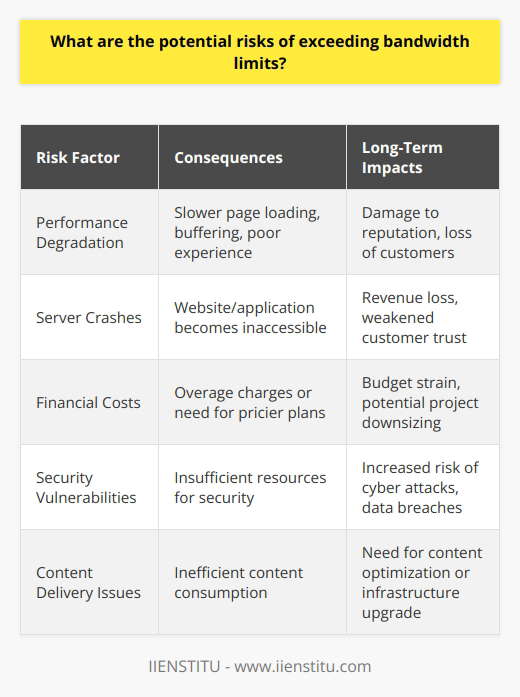
What consequences might result from exceeding one's bandwidth limit?
Impact on User Experience
Exceeding one's bandwidth limit may lead to significant consequences, both for the user and the internet service provider. One immediate implication of surpassing the allocated limit is a decline in user experience. As bandwidth is crucial for determining the speed and performance of an internet connection, exceeding the bandwidth cap often results in a slower and less responsive browsing experience.
Implications for Internet Service Providers
From the perspective of internet service providers, customers surpassing their bandwidth limit may present other complications. To manage network congestion and maintain adequate service levels for all users, service providers may enforce data prioritization, which could lead to a further deterioration of user experience for those exceeding their limit.
Additional Costs and Penalties
Moreover, financial repercussions may arise when users exceed their bandwidth allowance. Many internet service providers implement policies that charge customers additional fees for exceeding their allotted bandwidth. The burden of these supplementary expenses can be significant, discouraging users from surpassing their limits. Furthermore, excessive bandwidth usage may violate the terms and conditions of a subscriber's contract, exposing them to potential penalties or termination of their internet service.
Network Strain and Optimization
The overuse of bandwidth also places a strain on network resources, which could impact users across the network. In order to maintain consistent service quality across subscribers, internet service providers may be required to invest in network infrastructure upgrades or implement traffic management techniques. These added costs could eventually be passed on to all customers, leading to higher subscription fees.
In conclusion, exceeding one's bandwidth limit can have multiple negative consequences, including diminished user experience, additional costs and penalties, and a strain on provider resources. To avoid these issues, it is essential for users to monitor their bandwidth usage and select an appropriate plan to meet their needs. Service providers can also assist in managing bandwidth effectively by offering tools for detecting and controlling excessive usage.

How can one interpret and respond to bandwidth limit restrictions in the context of website optimization?
Understanding Bandwidth Limit Restrictions
To effectively interpret and respond to bandwidth limit restrictions, one must first comprehend the concept of bandwidth in website optimization. Bandwidth refers to the amount of data that can be transferred between a website's server and its visitors within a specific period. Essentially, higher bandwidth enables faster loading times and improved website performance, while lower bandwidth may lead to slower speeds and reduced user satisfaction.
Responsiveness to Restrictions
When facing bandwidth limit restrictions, developers can adopt several strategies to enhance website optimization. Firstly, they can consider compressing images and other multimedia elements on their site. This involves reducing file sizes without compromising the visual quality, allowing for quicker data transfer and less bandwidth usage.
Leveraging Caching Techniques
Another effective response to bandwidth restrictions is the implementation of caching techniques. By storing frequently requested data in a temporary storage area, caching reduces the need for information to be repeatedly transmitted between the server and the user. This results in decreased bandwidth consumption and faster website performance.
Minimizing Resource Requests
Additionally, minimizing resource requests from a website's server can help lower bandwidth usage. Developers can achieve this by combining multiple JavaScript or CSS files into single files, reducing the number of HTTP requests needed to render a page. This consolidation of resources aids in mitigating the effects of bandwidth limitations on website optimization.
Adopting Content Delivery Networks
Lastly, employing Content Delivery Networks (CDNs) can be a valuable strategy in addressing bandwidth concerns. CDNs are distributed networks of servers that store copies of a website's content and deliver it to users based on their geographical location. By utilizing a CDN, a site can effectively distribute bandwidth usage across multiple servers, thus alleviating the impact of restrictions on site performance.
Conclusion
In conclusion, interpreting and responding to bandwidth limit restrictions in the context of website optimization involves understanding the implications of bandwidth on site performance and implementing strategies to mitigate its effects. By compressing multimedia elements, leveraging caching techniques, minimizing resource requests, and adopting CDNs, developers can enhance website optimization and effectively tackle bandwidth limitations.
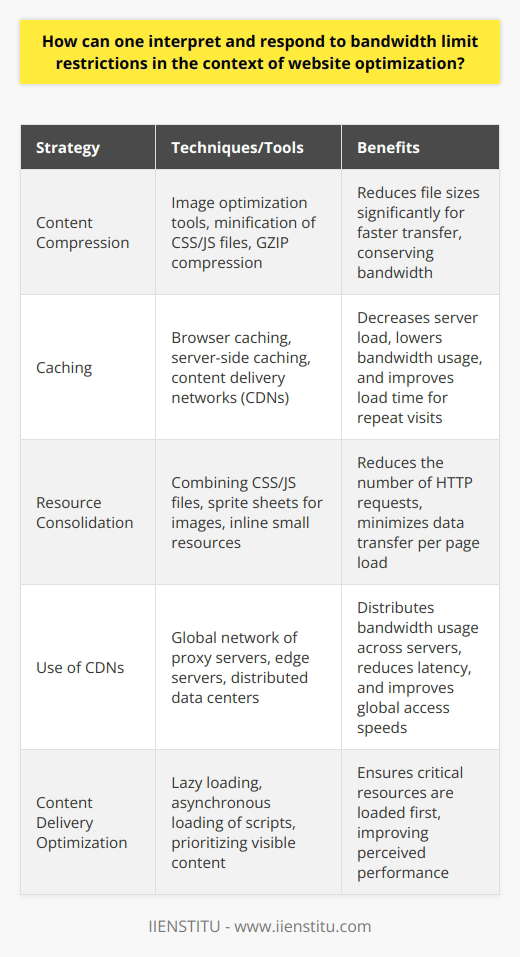
In terms of website performance and visitor experience, what effects can be observed when bandwidth limits are surpassed?
Effects on Website Performance
When bandwidth limits are surpassed, website performance can be significantly impacted in various ways. Firstly, it will result in slower loading times for web pages due to the reduced amount of data that can be transmitted per second. This can lead to visitors becoming frustrated and possibly abandoning the site altogether.
Decreased Site Responsiveness
Another effect of exceeding bandwidth limits is decreased site responsiveness. As more users access the site, the strain on the server increases, leading to a delay in processing requests. This can manifest as slow navigation, difficulties playing multimedia content, and even crashes.
Loss of Functionality
In severe cases, exceeding bandwidth limits may cause loss of functionality or even temporary unavailability of the site. When data transfer limits are reached, servers might automatically throttle or block access to preserve resources or avoid further degradation of service. This, in turn, can result in visitors being unable to access desired content, and ultimately harm the site's reputation.
Influence on Visitor Experience
As bandwidth limits are surpassed, visitor experience can be negatively affected in several ways. The reduced speed of the site, coupled with decreased responsiveness, can severely impact user satisfaction. Since a pleasant and efficient browsing experience is important to keep visitors engaged, these factors may cause visitors to abandon the site for a more responsive alternative.
Increase in Bounce Rates
The degradation of website performance as a result of exceeded bandwidth limits can also result in an increase in bounce rates. Bounce rate is the percentage of visitors who leave the site after viewing only one page. When faced with slow loading times and reduced functionality, users may lose patience and immediately exit the site. This can impact a site's search engine ranking and visibility.
In conclusion, surpassing bandwidth limits can have detrimental effects on both website performance and visitor experience. It leads to slower loading times, decreased site responsiveness, loss of functionality, a negative impact on user satisfaction, and increased bounce rates. To maintain a positive browsing experience and retain visitors, website owners should carefully monitor their bandwidth usage and consider upgrading their hosting package or investing in a content delivery network to handle additional traffic.

What factors contribute to a website reaching its bandwidth limit?
Factors Affecting Bandwidth Limit
Server Capacity
One contributing factor to a website reaching its bandwidth limit is the server capacity. A server can only handle a specific number of simultaneous connections and data transfers before becoming overwhelmed, which may result in slower page load times or users receiving error messages due to insufficient bandwidth.
Traffic Volume
Another factor is the overall traffic volume that a website experiences. High amounts of visitor traffic, especially during peak periods, can consume a significant proportion of available bandwidth. Websites that frequently experience heavy traffic, such as e-commerce or media sites, may require larger bandwidth allocations to accommodate user demand.
Types of Content
The types of content served on a website also impact bandwidth consumption. Websites featuring a large amount of high-resolution images, video, or audio content require more bandwidth to transfer these data-heavy files to users' devices. Therefore, sites with primarily text-based content typically consume less bandwidth in comparison.
Website Optimization
The level of website optimization also plays a role in bandwidth usage. Sites that are not optimized for performance, such as those with uncompressed images or inefficient code, may experience slower load times and increased bandwidth consumption. Implementing optimization techniques, such as compressing images and minifying code, can reduce the amount of bandwidth needed for successful content delivery.
User Behavior
User behavior on a website can also contribute to the exhaustion of bandwidth limits. For example, downloading large files or streaming video content consumes more bandwidth than browsing text-based pages. Websites that encourage or facilitate these types of user activities may require more significant bandwidth allocations to accommodate their target audience.
Conclusion
Multiple factors contribute to a website reaching its bandwidth limit, including server capacity, traffic volume, types of content, website optimization, and user behavior. Understanding and addressing these factors can help website administrators assess their bandwidth needs accurately and make necessary adjustments to ensure optimal performance and user experience.

How can website owners effectively monitor and manage their bandwidth usage?
**Monitor Usage with Analytics Tools**
Website owners can effectively monitor and manage their bandwidth usage by employing analytics tools that track user activity and resource consumption. By analyzing data collected from these tools, they can identify trends and patterns in bandwidth utilization.
**Content Optimization Techniques**
To manage bandwidth usage, website owners can implement content optimization techniques such as image compression, minification of CSS and JavaScript files, and enabling browser caching. These practices reduce file sizes and the number of server requests, ultimately conserving bandwidth resources.
**Content Delivery Network (CDN) Integration**
Another effective strategy for managing bandwidth usage is to integrate a Content Delivery Network (CDN) into the website's architecture. CDNs distribute web content across multiple servers, reducing the load on a single server and enhancing user experience through faster content delivery.
**Implementing Adaptive Bitrate Streaming**
For websites featuring video content, implementing adaptive bitrate streaming can significantly decrease bandwidth consumption. This technology adjusts video quality based on the viewer's device and connection speed, using only the necessary bandwidth to deliver a smooth viewing experience.
**Regularly Review Hosting Plans**
Lastly, website owners should regularly review their hosting plans and assess whether they provide sufficient bandwidth resources to accommodate their website's traffic and content demands. Upgrading or optimizing the hosting plan can help prevent bandwidth overages and service disruptions.
In summary, website owners can manage and monitor their bandwidth usage effectively by utilizing analytics tools, optimizing web content, integrating a CDN, implementing adaptive bitrate streaming, and regularly reviewing their hosting plans. These measures help ensure a seamless user experience and efficient consumption of bandwidth resources.
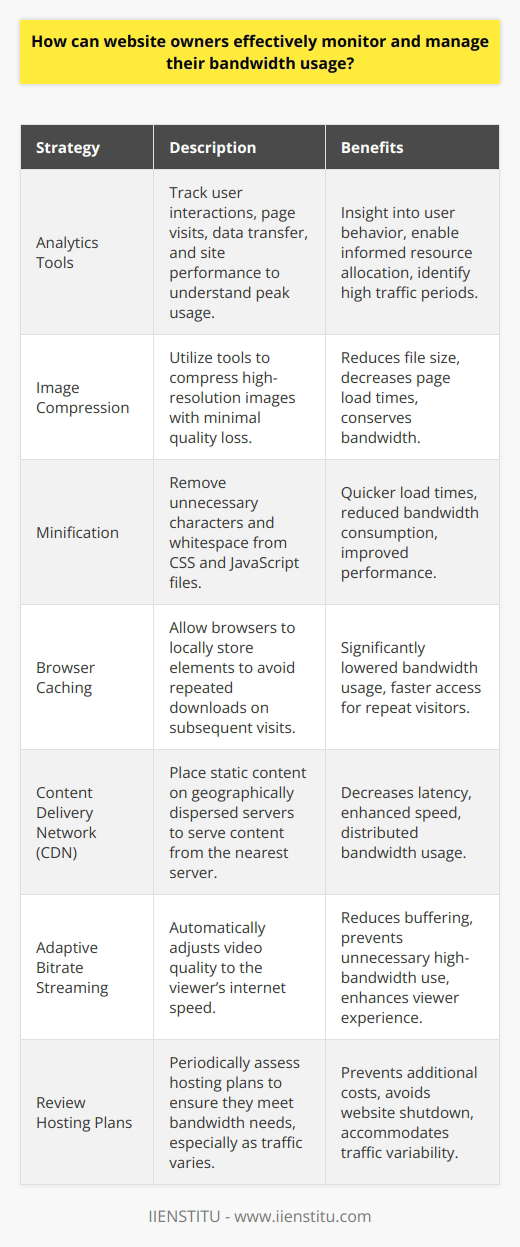
Are there any long-term ramifications on SEO rankings due to consistently exceeding bandwidth limits?
Impact on Web Performance and User Experience
Exceeding bandwidth limits can significantly impact SEO rankings due to its detrimental effects on web performance and user experience. Search engines, such as Google, prioritize websites that deliver fast-loading, user-friendly content.
Page Load Speed and Bounce Rates
A direct consequence of exceeding bandwidth limits is slow page load speeds, which frustrates users and deters them from browsing the site thoroughly. Slow-loading pages lead to high bounce rates, indicating visitors exiting the site soon after landing on it. Search engines interpret this as an indication of a low-quality website, and consequently, lower its SEO rankings.
Mobile Broadband and Device Compatibility
Furthermore, with the growing importance of mobile broadband and device compatibility, search engines increasingly consider mobile-friendly design and speed as significant ranking factors. Exceeding bandwidth limits hampers the ability to provide a seamless experience across various devices and inhibits a website's mobile compatibility, thus leading to a decline in its SEO rankings over time.
Content Accessibility and Crawl Efficiency
As bandwidth consumption exceeds its limits, web hosting providers may temporarily suspend a website to mitigate server overload. This results in content inaccessibility for both users and search engine crawlers. This lack of content accessibility reduces the efficiency of search engines in crawling the website, leading to outdated or missing information in their index. Such an outdated index negatively affects the website's ability to rank higher in search engine results pages (SERPs).
Competitive Disadvantage and Relevance
Finally, consistently exceeding bandwidth limits places the website at a competitive disadvantage in the dynamic online landscape. With competitors improving their websites' loading speed and user experience, maintaining subpar performance actively contributes to the website's irrelevance in search results. Consequently, search engines downrank the website in both organic and paid results.
Conclusion
In conclusion, there are notable long-term ramifications on SEO rankings due to consistently exceeding bandwidth limits. Ranging from the detrimental impact on user experience to the competitive disadvantage it creates, websites must strive to optimize their bandwidth usage and web performance to enhance their search engine visibility and maintain a strong online presence.
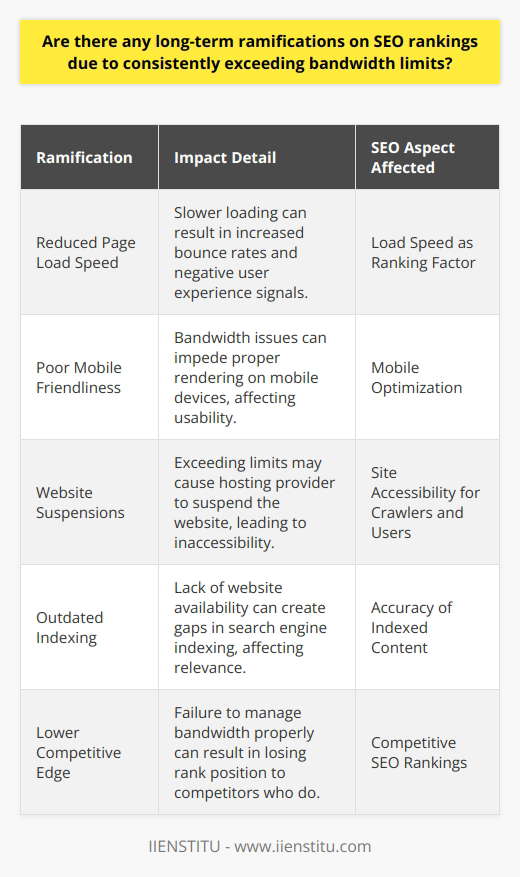
What are some strategies that can be implemented to prevent exceeding bandwidth limits?
Strategies for Bandwidth Limit Prevention
Monitoring Bandwidth Usage
One strategy for preventing exceeding bandwidth limits is to regularly monitor bandwidth usage. By frequently measuring data consumption, individuals and businesses can track how close they are to reaching their limits, allowing them to make adjustments accordingly. Tools such as bandwidth monitoring software can provide detailed information and real-time data on usage patterns, helping users stay within their allotted limits.
Optimizing Content
Another technique to avoid surpassing bandwidth limits is to optimize content, especially when it comes to multimedia files such as images, audio, and video. These files can be quite large and consume significant amounts of bandwidth. By compressing these files and employing formats that require less data transmission, users can reduce the overall bandwidth consumption without sacrificing content quality. Additionally, implementing caching mechanisms can help offload redundant data transmissions, further reducing the chance of exceeding bandwidth limits.
Usage Policies
Implementing usage policies is another effective strategy in managing bandwidth consumption. Organizations can establish guidelines that outline the acceptable use of network resources, with the goal of limiting non-essential activities that may consume significant amounts of bandwidth. Examples of such policies include restricting access to streaming services, limiting file download or upload sizes, and regulating the use of bandwidth-intensive applications.
Quality of Service (QoS)
Using Quality of Service (QoS) techniques can also help ensure that critical applications and services receive the necessary bandwidth. QoS involves prioritizing specific network traffic based on predefined criteria, such as application type or user group. By doing so, users can allocate bandwidth resources effectively, ensuring that vital applications have the necessary amount of bandwidth while limiting the bandwidth available for less critical functions.
Scheduling Data Transfers
Scheduling data transfers during off-peak hours can help avoid reaching bandwidth limits. By transferring large files or performing bandwidth-intensive tasks during times of lower network demand, users can help spread bandwidth consumption more evenly throughout the day and avoid overtaxing the network during peak hours.
In conclusion, implementing a combination of these strategies can significantly reduce the likelihood of exceeding bandwidth limits. Regularly monitoring usage, optimizing content, establishing usage policies, utilizing QoS techniques, and scheduling data transfers can all contribute to more efficient and effective bandwidth management practices.

How does the type of web hosting plan impact a website's bandwidth capacity and overall performance?
Impact on Bandwidth Capacity
The type of web hosting plan that a website owner chooses significantly affects the website's bandwidth capacity. For instance, shared hosting plans typically offer limited bandwidth as multiple websites share the same server space. Consequently, in peak traffic times, the website may experience slower page load speeds and even downtimes, which can negatively impact the user experience.
Comparative Performance of Hosting Plans
Alternatively, virtual private server (VPS) hosting and dedicated hosting plans ensure better performance due to reduced competition for server resources. In VPS hosting, the website's server is divided into virtual environments where resources like bandwidth are allocated more equitably. Dedicated hosting, on the other hand, offers an entire server solely dedicated to the website, which optimizes performance by effectively eliminating resource contention.
Scalability of Web Hosting Plans
The ease of scalability of a web hosting plan can impact a website's ability to grow and support higher traffic volumes. Shared hosting plans are generally cheaper options, but they present limitations when trying to scale up as the increased request for bandwidth may negatively affect neighboring websites on the server. In contrast, VPS and dedicated hosting plans can facilitate immediate resource allocation adjustments to accommodate growth, making them suitable hosting solutions for websites with more demanding requirements.
Hosting Plans and User Experience
Ultimately, an optimal user experience necessitates reliable website performance and swift loading times. Consequently, it is crucial to consider the potential performance implications that can arise from the chosen web hosting plan. Websites with higher anticipated traffic should consider plans that provide higher bandwidth and dedicated resources, such as VPS or dedicated hosting plans, to ensure smooth and efficient performance.
In conclusion, the type of web hosting plan has a significant impact on a website's capacity to maintain efficient performance and cater to the bandwidth needs of its users. By carefully considering and selecting appropriate hosting plans, website owners can minimize disruptions, maintain fast loading times, and prioritize an optimal user experience.
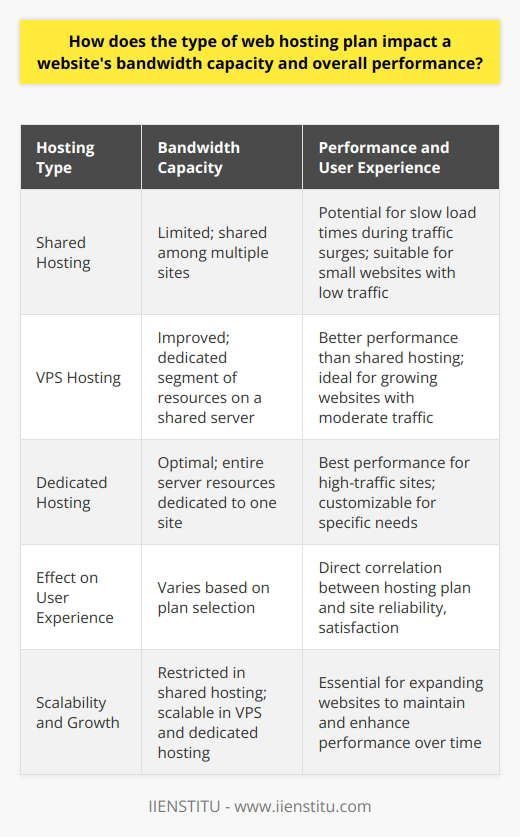
Can the choice of content delivery network (CDN) influence a website's bandwidth usage and optimization?
CDN Impact on Bandwidth Usage and Optimization
Content Delivery Networks Influence
Given the crucial role that Content Delivery Networks (CDNs) play in efficiently distributing content over the internet, it is clear that the choice of CDN can significantly influence a website's bandwidth usage and optimization. CDNs essentially function by caching static content on distributed servers, thereby reducing latency and improving load times for users accessing the site from different locations. Consequently, the choice of CDN can have a profound impact on the overall performance of a website.
Effect of CDN's Global Reach
Selecting a CDN with a wide network of data centers around the world can ensure content gets delivered to users in a more expedited manner, leading to reduced bandwidth consumption and a higher degree of optimization. By distributing content across a variety of geographical locations, CDNs can optimize a website's load time and minimize the need for users to repeatedly download the same content. This reduces the load on the origin server, saving bandwidth, and enhancing the user experience.
Integration of Load Balancing
An important aspect of CDN choice is load balancing functionality, which serves to distribute user requests across several servers, preventing congestion and further enhancing website optimization. By providing intelligent traffic routing based on factors such as user location, server health, and anticipated traffic patterns, load balancing functionality can improve website performance and significantly reduce bandwidth usage.
Caching Policies and Compression Techniques
Moreover, a CDN choice that offers customizable caching policies and advanced compression techniques will further optimize bandwidth usage by allowing a website to cache as much of its content as possible, without forfeiting freshness or accuracy. Effective caching reduces the need for users to download content from the origin server, cutting bandwidth usage and optimizing delivery. Meanwhile, employing compression techniques can shrink file sizes, allowing for faster content delivery and reduced bandwidth consumption.
In conclusion, the choice of Content Delivery Network can indeed have a significant impact on a website's bandwidth usage and optimization. By selecting a CDN with global reach, load balancing functionality, customizable caching policies, and advanced compression techniques, website administrators can optimize their site's performance, minimize bandwidth costs, and enhance the overall user experience.
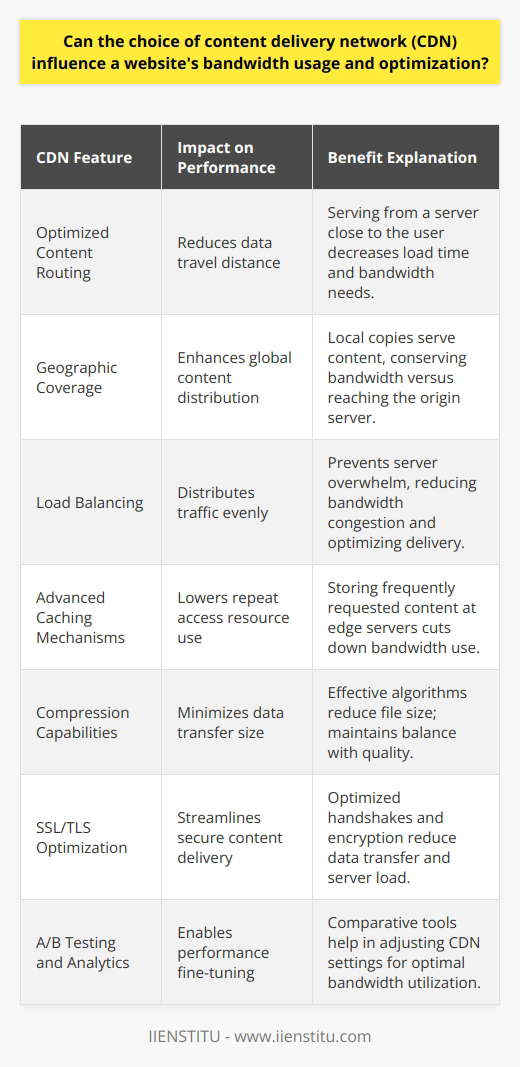
Why is SEO so difficult?
Understanding SEO's Complexity
SEO, or Search Engine Optimization, often presents difficulties due to its multifaceted character. A multitude of elements play into a successful SEO strategy, making it complex to master.
Impact of Algorithm Changes
Search engines like Google frequently update their algorithms. These updates can significantly alter ranking factors, thus requiring constant adaptation. This dynamic landscape means that SEO success is not static, making it challenging to maintain.
Importance of Quality Content
Producing high-quality content is a vital aspect of SEO. This involves careful keyword selection, research, and strategic implementation. Yet creating content that is both SEO-friendly and engaging to the reader is a fine balancing act that requires skill.
Link Building Challenges
Effective link-building is another challenging aspect of SEO. Gaining backlinks from authoritative websites helps boost your ranking. However, managing this efficiently while maintaining relevance and quality is difficult.
Increasing Competition
The online landscape is highly competitive. Millions of websites compete for visibility, making it harder to stand out. This vast competition makes SEO a challenging yet crucial task for online success.
Technical Aspects of SEO
SEO involves technical aspects such as website design, site speed, and mobile optimization, which may be challenging for those without technical know-how. Understanding these components and effectively implementing them adds further complexity.
Hence, SEO's difficulty is attributed to its dynamic nature, the need for high-quality content, link building challenges, increasing competition, and technicalities. Despite these challenges, SEO remains an essential online marketing strategy in the digital era.
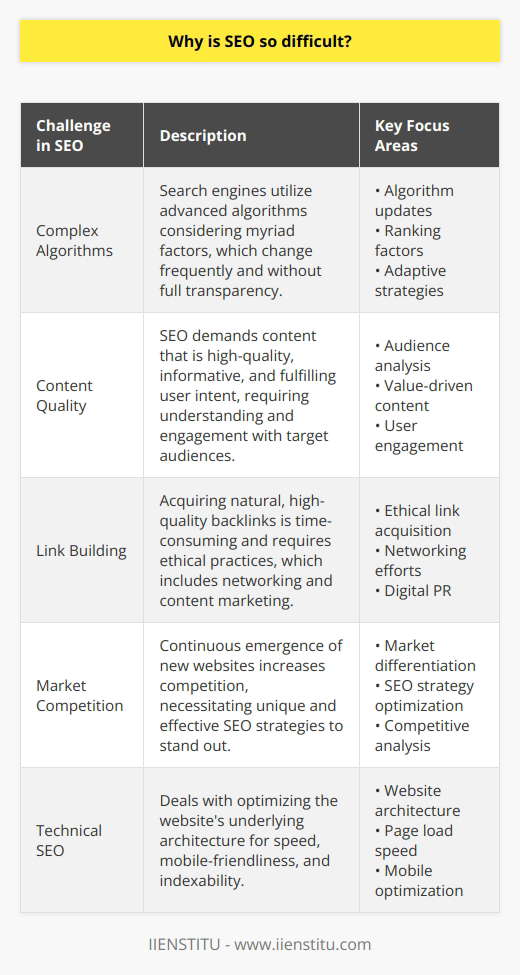
What are the most common SEO mistakes?
Common SEO Mistakes
Keyword Misuse
A common SEO mistake is keyword misuse. Bloggers often either use too many keywords or not enough. Overuse leads to keyword stuffing, a practice that search engines penalize. Conversely, underuse results in not capitalizing on potential search traffic.
Insufficient Content
Creating insufficient or thin content is another mistake. Search engines prioritize high-quality, unique content. Posting sparse, low-value content can result in poor ranking.
Ignoring Local SEO
Many bloggers ignore local SEO, focusing solely on general SEO strategies. By neglecting local SEO, they miss valuable, location-specific traffic.
Ignoring User Experience
Poor user experience can also be detrimental. This includes slow page loading speed, bad mobile compatibility, and complicated navigation. These aspects can affect both visibility and user engagement.
Lack of Metadata
A lack of appropriate metadata can impede visibility. Meta descriptions and titles aimed at both users and search engines can enhance visibility.
Neglected Backlink Profile
Many bloggers neglect their backlink profile. Quality backlinks enhance a site's trustworthiness in the eyes of search engines.
Duplicate Content
Publishing duplicate content is another common mistake. It can confuse search engines and lead to low visibility.
Not Using Analytics
Finally, not using analytics tools to understand and improve performance is a significant oversight in SEO. These tools are invaluable for uncovering SEO opportunities and weaknesses.
By avoiding these common SEO errors, bloggers can improve their site's search engine ranking and increase their traffic. Remember, effective SEO is about quality over quantity and acting with an understanding of search engine algorithms.
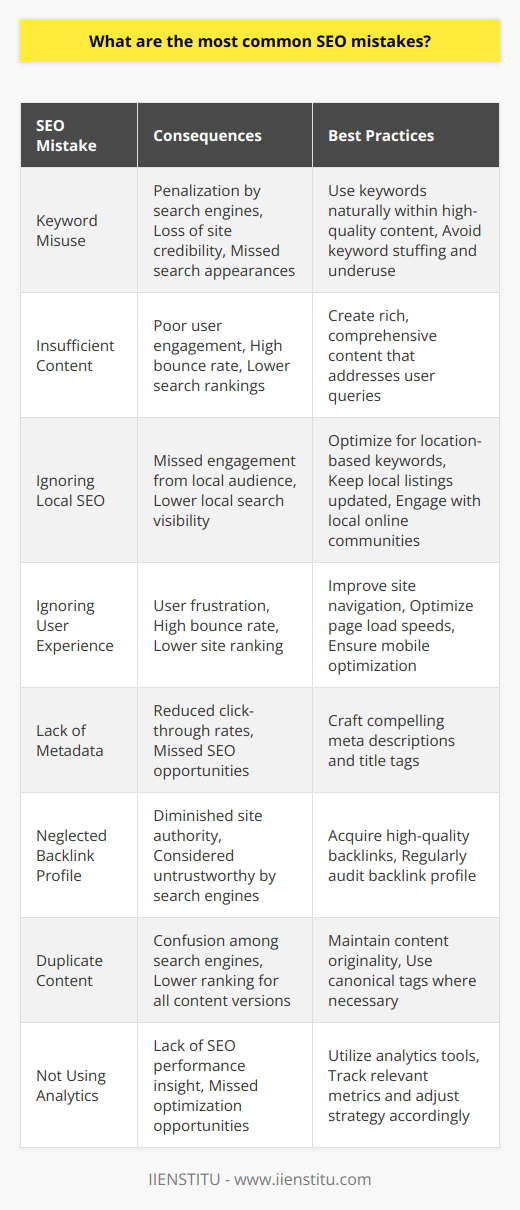
What is SEO in layman's terms?
Understanding SEO
The acronym SEO stands for Search Engine Optimization. Simply put, it is a set of strategic actions intended to elevate a website's visibility on internet search engines.
Concept of SEO
At its core, SEO is about understanding how search engines work. It involves manipulating elements of a website so that it becomes more desirable to these engines, resulting in greater online visibility.
Function of SEO
SEO influences the 'organic' or unpaid search results. When a person conducts an online search, the search engine will typically display numerous pages of results. These results are ranked based on relevance and quality, as determined by the engine's complex algorithms. SEO enables a website to appear high in these rankings.
Importance of Keywords
Keywords play a fundamental role in SEO. They are terms or phrases that potential visitors might type into a search engine when looking for the content a website provides. Including these keywords on the webpage helps the site match more search queries, thereby receiving a high ranking.
Significance of Quality Content
Alongside keywords, the production of quality content is integral to SEO. Search engines prioritize websites that offer relevant and valuable content to users. Thus, creating substantial, engaging materials can significantly enhance a website's search engine ranking.
Link-Building in SEO
Another vital element of SEO is link-building, which involves acquiring hyperlinks directing to one’s website from other sites. Search engines view these links as endorsements, whereby a high count results in improved rankings.
In conclusion, SEO, in layman's terms, is about making a website more visible and appealing to search engines. It involves the strategic use of relevant keywords, quality content, and link-building. Its ultimate aim is to attract more visitors by ranking high on search engine result pages.
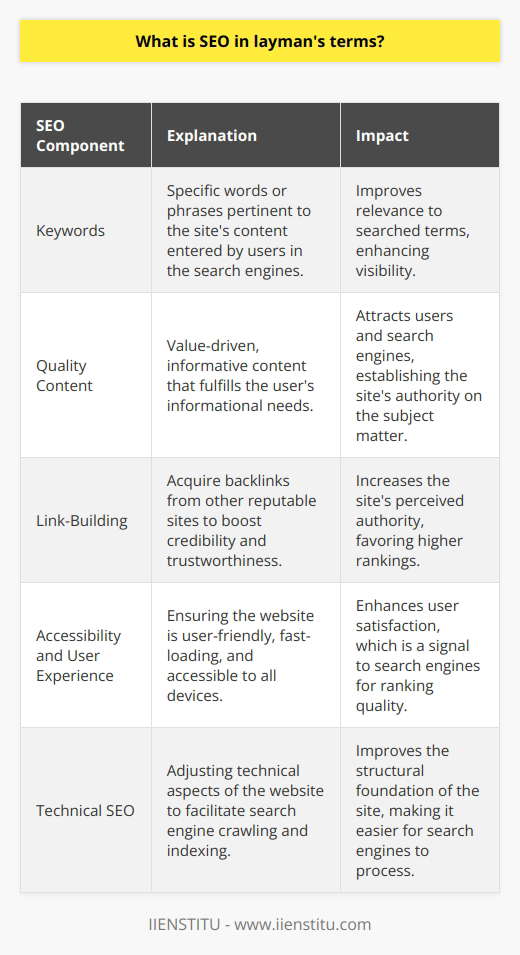
What happens if you ignore SEO?
Decreased Visibility
If you ignore SEO, your website or blog's visibility might reduce significantly. Search engines can fail to recognize your content, affecting its ranking leading to less visibility.
Reduced Traffic
Ignoring SEO can also reduce web traffic. People are less likely to visit your site if they cannot find it during their online searches. Decreased traffic can contribute to less engagement on your site.
Poor User Experience
Not implementing SEO can result in a poor user experience. SEO is not just about keywords, but also about making your site user-friendly. Without a good structure and quality content, visitors may leave your site quickly.
Low Sales or Subscriptions
For businesses, ignoring SEO might result in lower sales or less customer engagement. If your site lacks visibility, it may be challenging to reach potential customers and convince them to purchase your products or subscribe to your services.
Reduced Credibility
Neglecting SEO can be detrimental to your reputation. A well-optimized site appears more reliable and convinces users that the site owner cares about providing quality content. A good rank also helps build trust with users.
Hindered Growth
SEO is a crucial element for online growth. Without it, your site may struggle to reach and retain the target audience, hindering your potential for growth.
In conclusion, ignoring SEO can negatively impact your site's visibility, user experience, credibility, and potential growth. Proper SEO not only makes your site more discoverable but also enhances the user experience, contributing to the overall success of your online presence.
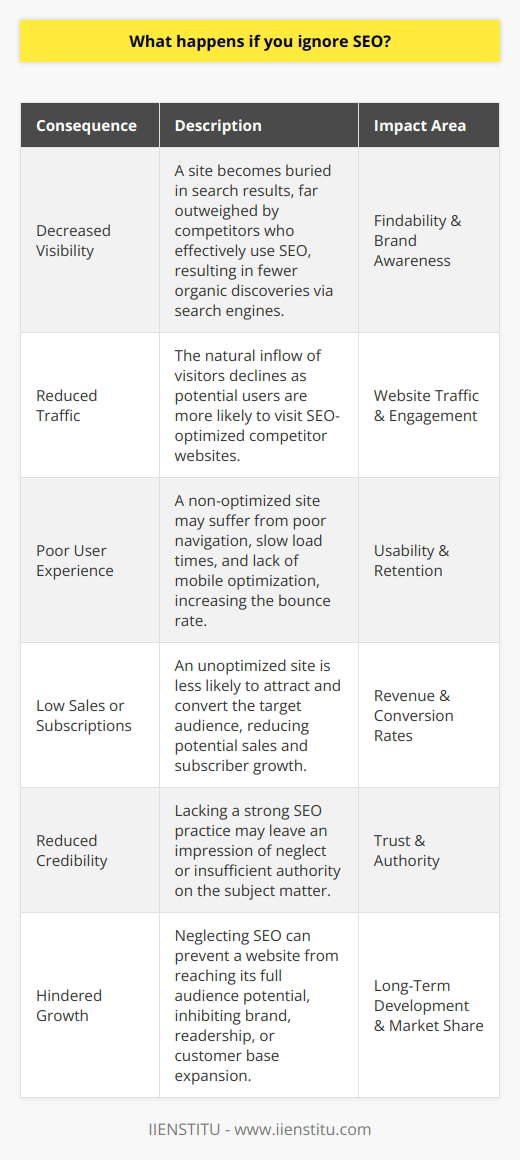
In the context of search engine algorithms, how do bandwidth limitations impact SEO performance?
Understanding Bandwidth Limitations
Bandwidth refers to the maximum rate of data transfer across a given path. For search engines, bandwidth constraints can negatively impact SEO performance.
Impact on Search Engine Indexing
Limited bandwidth inhibits a search engine's ability to index web pages. This indexing is vital as search engines use it to determine the relevance of a webpage to a specific search query.
Interference with Crawling
Bandwidth limitations also interfere with the search engine's crawling process. The slow transmission of data slows down web spiders, impacting the frequency and depth of their crawl.
Effect on User Experience
From a user experience perspective, bandwidth restrictions hinder webpage loading speed. Slow websites tend to have higher bounce rates, which can impact SEO rankings negatively.
Importance of Efficient Web Design
To mitigate this, efficient web design techniques should be adopted. These include minimizing HTTP requests, optimizing images and enabling browser caching. These steps will optimize bandwidth usage, thus improving SEO performance.
In conclusion, bandwidth limitations can directly and indirectly impact SEO performance by affecting how often and how successfully search engine spiders can crawl and index a website. Therefore, website developers should strive to optimize their sites to use bandwidth more efficiently.
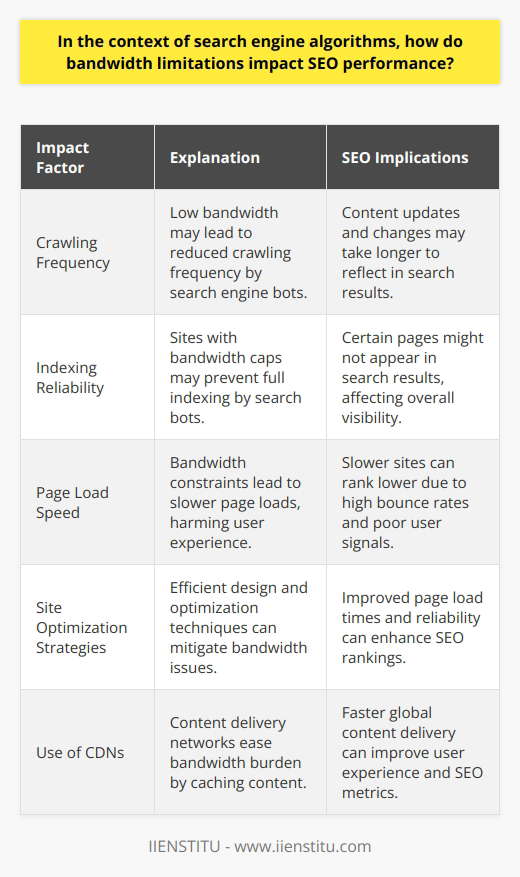
Are there specific industries or niches that face unique SEO challenges?
Unique SEO Challenges in Specific Industries
Certain industries indeed grapple with exclusive SEO issues. The constant evolution of Search Engine Optimization (SEO) demands specificity and adaptability from each sector.
Remarkable Challenges in the Healthcare Industry
Healthcare providers encounter stringent compliance regulations. For instance, patient data protection rules limit what professionals can post online. Avoiding potential violations requires careful SEO strategies.
eCommerce: An Embattled Sector
E-commerce businesses struggle due to fierce competition and product assortment. These enterprises must SEO-optimize numerous product pages, which is a time-consuming task.
Finance Industry’s Trust Issue
SEO professionals in the finance sector grapple with trust issues among consumers. Establishing trustworthiness through SEO strategies often proves challenging.
Impact on Highly-Regulated Industries
In highly-regulated industries like pharmaceuticals, companies must tread carefully with SEO. They face severe penalties for false medical claims or misleading consumers.
Challenges for Localized Service Providers
Localized service providers like plumbers or locksmiths find it hard to rank high in SERPs. SEO becomes challenging due to the limited scope and localized competition.
Stiffer Competition in Popular Niches
In popular niches, high volumes of existing content make standing out difficult, hence limiting SEO effectiveness. This requires creativity and tenacity in implementing SEO strategies.
Struggles of Emerging Industries
Emerging industries struggle with a lack of search volume. The nascent stage of these industries often results in limited available keywords and thus, limited SEO opportunities.
Conclusion
The unique realities of each industry demand distinct SEO strategies. Overcoming these sector-specific challenges is pivotal in achieving a profitable online presence. However, it requires thorough market understanding, expertise in SEO, and exceptional adaptability.
